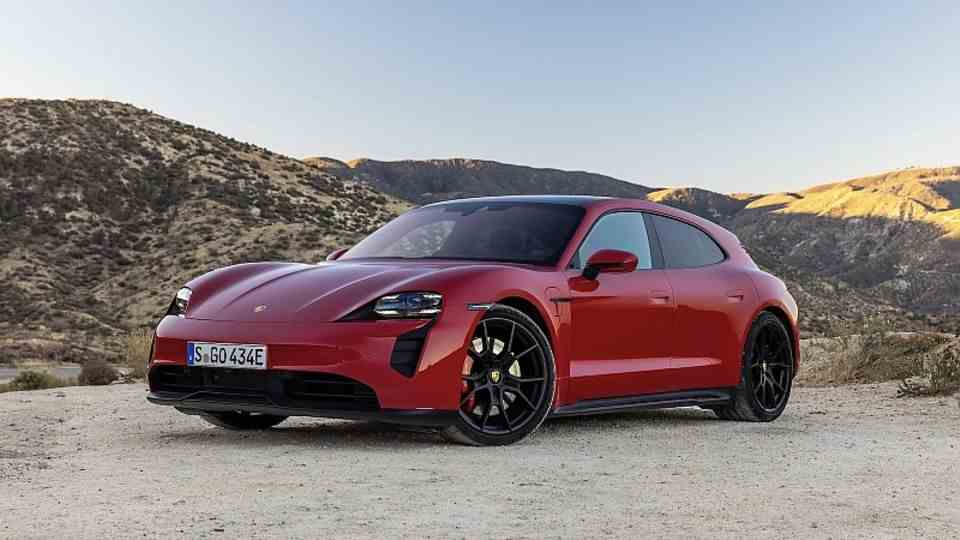Electric car as electricity supplier
How the Porsche Taycan should prevent fluctuations in the power grid
The energy of the Porsche Taycan model should be able to strengthen the public power grid
©Porsche
An electric car could use its energy to strengthen the public power grid in mode – Porsche says it has succeeded in doing this in a pilot project with Taycan models. Various car manufacturers are working on the technology to store green electricity and prevent fluctuations in the power grid.
An electric car spends most of its life in a parked state – time that can be used to supply the public power grid with energy from the drive battery.
Porsche has now successfully tested this process, known as vehicle-to-grid technology (V2G), as part of a pilot project. In cooperation with the transmission system operator TransnetBW from Baden-Württemberg and the consulting company Intelligent Energy System Services, the German car manufacturer has connected five production vehicles of the Taycan model to the power grid under both domestic and laboratory conditions. Porsche announced this on Friday.
With the help of V2G, energy could be fed back into the public power grid in the future. And numerous vehicles could therefore jointly create the control power, i.e. a reserve power. This should compensate for fluctuations in the power grid, they say. And with the expansion of renewable energies, control power for secure grid operation will become even more important in the future.
Porsche speaks of a “win-win situation”. With their built-in high-voltage batteries, electric cars could be used as buffer storage – so far, power plants have cushioned the fluctuations in the power grid. For drivers of e-cars, this would also have a financial benefit: “(They) could have their contribution to balancing energy compensated,” says Porsche.
According to the car manufacturer, the core element of the technology is a cloud-based pooling system that coordinates the charging processes of the electric vehicles. Accordingly, it translates the network operator’s control reserve setpoints into vehicle-specific signals that control the charging processes in real time. The pooling system also regulates data transport.
Lutz Meschke, Deputy Chairman of the Executive Board and Head of Finance and IT at Porsche AG, says: “Such a pooling system can not only be used for the balancing power market. Extended solutions for green charging and other vehicle-to-grid applications are also conceivable.” If, in future, electric vehicles feed electrical energy back into the grid, for example from private photovoltaic systems, and thus contribute to the expansion of regenerative energy, this will further increase the acceptance of e-mobility.
Rainer Pflaum, CFO TransnetBW, speaks of a “real, measurable milestone”. “The project team managed to implement the complex communication infrastructure between our control system and several electric vehicles. At the same time, the strict specifications for maintaining and providing control reserves were met,” says Pflaum.
Not only Porsche is working on V2G technology
Other car manufacturers are also working on V2G technology. The South Korean carmaker Hyundai claims to have developed a technology for feeding electricity into the public power grid, as the company also announced on Friday. Accordingly, households and buildings can be supplied with electricity in equal measure. Appropriate hardware and a bi-directional charger that allows both charging and discharging of the battery is required to feed in the power.
If the e-car then has to be recharged with electricity itself, its owner can, in combination with a flexible electricity tariff, charge “in good time and at lower costs” during off-peak times. The network operators also benefit from lower operating costs, for example due to the elimination of intermediate storage.
The process reduces CO2 emissions and decreases dependence on fossil fuels. Instead of operating reserve power plants with high emissions, the power grid can draw on green electricity stored in the high-voltage batteries of the electric vehicles, writes Hyundai.
The South Korean carmaker is currently running two pilot projects in Germany and the Netherlands with Ioniq 5 vehicles – the crossover already has the ability for bidirectional charging. Tests are being carried out in Berlin to determine the extent to which electricity can be shared with the house within a closed energy system. In the Dutch city of Utrecht, a fleet of 25 Ioniq 5 vehicles will be made available to residents of a recently built housing estate in the form of car sharing. The ultimate goal is to make Utrecht the first bidirectional city in the world.
Hyundai wants to introduce a new electric vehicle “soon” that has V2G technology ex works. Starting this year, VW also wants to mass-produce e-cars with a bidirectional charging system. In July 2021, as part of a pilot project, BMW handed over 50 BMW i3 vehicles with the function of feeding back electricity from their batteries to private and commercial customers. The related research project “Bidirectional Charging Management – BDL” started in May 2019.
Sources: Porsche, Hyundai, VW, bmw


